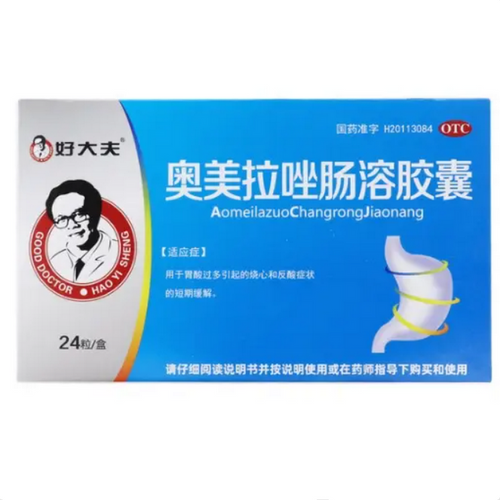Product Overview
[Drug Name]
Generic Name: Omeprazole Enteric-Coated Capsules
Trade Name: YiShu Omeprazole Enteric-Coated Capsules, 20mg x 36 capsules
Pinyin Code: YiShu AoMeiLaZuoChangRongJiaoNang 20mg x 36Li
[Main Ingredients]
The main ingredient of this product is omeprazole.
[Properties]
This product contains white or off-white enteric-coated pellets or granules.
[Indications/Main Functions]
Indicated for gastric ulcers, duodenal ulcers, stress ulcers, reflux esophagitis, and Zollinger-Ellison syndrome (gastrinoma).
[Specifications]
20mg x 36 capsules
[Dosage and Administration]
Oral administration, do not chew. 1. Peptic ulcer: 20mg (one capsule at a time), 1-2 times daily. Take orally once daily in the morning or once in the morning and evening. The treatment course for gastric ulcers is usually 4-8 weeks, and for duodenal ulcers is usually 2-4 weeks. 2. Reflux esophagitis: Take 20-60 mg (1-3 tablets at a time) once or twice daily. Take orally once in the morning or once in the morning and evening. The treatment course is usually 4-8 weeks. 3. Zollinger-Ellison syndrome: Take 60 mg (3 tablets at a time) once daily. The total daily dose can be adjusted to 20-120 mg (1-6 tablets) depending on the condition. If the total daily dose exceeds 80 mg (4 tablets), it should be taken in two divided doses.
[Adverse Reactions]
This product is well tolerated. Common adverse reactions include diarrhea, headache, nausea, abdominal pain, flatulence, and constipation. Rarely, elevated serum aminotransferases (ALT, AST), rash, dizziness, drowsiness, and insomnia may occur. These adverse reactions are generally mild and disappear spontaneously. Long-term treatment may lead to gastric mucosal cell hyperplasia and atrophic gastritis.
[Contraindications]
This product is contraindicated in patients with allergies or severe renal insufficiency.
[Drug Interactions]
1. Avoid concomitant use with oral imidazole antifungals such as ketoconazole, itraconazole, miconazole, and fluconazole. 2. Concomitant use of omeprazole and clarithromycin may increase the incidence of central nervous system (primarily headache) and gastrointestinal adverse reactions. 3. Avoid concomitant use with diazepam (Valium), phenytoin, warfarin, nifedipine, digoxin, cisapride, quinidine, caffeine, and theophylline. 4. Concomitant use with other medications may cause drug interactions. Consult a physician or pharmacist for details.
[Precautions]
1. Do not use for more than 7 days. If symptoms persist or disappear, consult a physician or pharmacist. 2. Do not re-use within 2 months. If symptoms recur, seek medical attention immediately. 3. Do not use this product if: swallowing is difficult or painful; vomiting blood; or if you have bloody or black stools. These may be signs of a serious condition; consult a physician. 4. Patients with impaired liver function or abnormal blood counts should use this product under the guidance of a physician. 5. If heartburn persists or worsens, discontinue use and seek medical attention. 6. This product should only be used by children under the guidance of a physician. 7. Use with caution during pregnancy or lactation. 8. In case of overdose or serious adverse reactions, seek medical attention immediately. 9. Contraindicated if allergic to this product; use with caution if allergic. 10. Do not use if the product's properties change. 11. Keep this product out of reach of children. 12. Children must be supervised by an adult before use. 13. If you are using other medications, consult a physician or pharmacist before using this product. Please read the instructions carefully and use according to your physician's instructions.
[Pediatric Use]
There is no experience with this product for children. It is contraindicated for infants and young children.
[Elderly Use]
This product is not available.
[Overdose]
Unknown.
[Pharmacology and Toxicology]
Proton pump inhibitor. This drug is a fat-soluble, weakly alkaline drug that easily concentrates in acidic environments. Therefore, after oral administration, it is specifically distributed in the secretory tubules of the gastric mucosal parietal cells. In this highly acidic environment, it is converted into its active form, the sulfenamide. It then irreversibly binds to the sulfhydryl group of the H+, K+-ATPase (also known as the proton pump) in the parietal cell secretory membrane via a disulfide bond, forming a sulfenamide-proton pump complex, thereby inhibiting the enzyme's activity and blocking the final step of gastric acid secretion. Therefore, this drug has a strong and long-lasting inhibitory effect on gastric acid secretion caused by various reasons.









